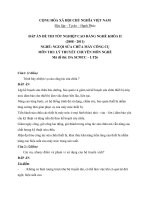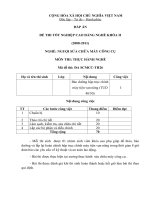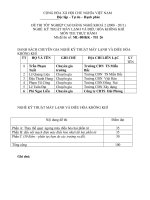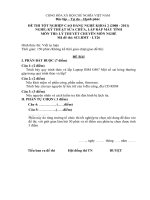PASSAGE 26
Bạn đang xem bản rút gọn của tài liệu. Xem và tải ngay bản đầy đủ của tài liệu tại đây (33.15 KB, 2 trang )
PASSAGE 26
In China, New Year's Day is on the first day of the first month of the lunar calendar. The date may
differ each year. It is at the end of January or in early February. People return home to China from all over
the world to celebrate the day. In other countries, people who live in big cities in areas called Chinatown
also celebrate.
The Chinese New Year is also called the Spring Festival. It is from the ancient tradition which marks
the end of winter and the beginning of spring with a celebration. It is the start of a new growing cycle on
the Earth. Family and friends get together. The event is full of colorful decorations and traditions. Chinese
New Year is over 4,000 years old.
Their celebration starts on New Year's Eve. A big party is held on the next day. The entire event lasts
15 days. After the 15 days, the Lantern Festival occurs at the time of the first full moon. The families start
getting ready for the event two weeks ahead of time. They clean their houses to get rid of all the bad luck
which has accumulated in the previous year. After the celebration, a person cannot clean a room for
several days or he might sweep out the good luck which has come in. Cleaning up also means apologizing
to friends and paying off bills.
Red and gold are the Chinese colors. Banners in these colors are hung everywhere as decorations with
wishes for good luck written on them. For the Chinese, red and gold are lucky colors. Red symbolizes life
and happiness. Gold symbolizes riches. Food must be prepared ahead of time because it is unlucky to use
a knife during the New Year's festival. A knife may cut off all the good luck for the New Year People
decorate their houses with some of the lucky plants. Orange trees, pussy willows and mandarin trees are
several which are bought.
A celebration can only begin after the family pays respect to their dead relatives. On New Year's Eve,
the families go to the temple to pray for good luck in the coming year. They carry food or incense to try to
please the spirits of the dead. Chinese red and gold lanterns are hung all around the towns. Firecrackers
are also a big part of the celebration. They are lit outside businesses and houses to scare away bad spirits.
They are also a part of the big parades.
A lion performance is acted out by two people. One holds the head and one the body of the lion. The
performers put on acrobatic stunts. The lion actors run along the streets accompanied by drums, gongs
and cymbals. Their purpose is to bring goodwill to all. A 'laughing Buddha' goes along with the lion
actors. He teases the lion and makes him fall down and roll around. People standing along the road place
red envelopes into the lion's mouth. They contain money which is a donation for whatever martial arts
school is putting on the show. Sometimes a business hangs a head of lettuce from the ceiling. The actor in
the lion outfit has to reach up and pick off the red envelope from inside the lettuce. Then the lion spits out
the leaves to spread good luck. At the end of the performance, a scroll pops out of the lion's mouth
carrying a message of good luck. The usual colors for the lion outfit are red, green and gold.
Question 1. What topic does the passage mainly discuss?
A. Chinese New Year.
B. The Preparations for New Year in China.
C. The celebration of New Year's Day in China. D. Activities in Chinese New Year.
Question 2. What sentence is NOT true?
A. the New Year date in China may not be the same every year.
B. the Chinese New Year marks the start of winter and the end of spring.
C. The celebration is decorated with colors and traditions.
Page 1
D. the Chinese New Year began to be celebrated more than 4 thousand years ago.
Question 3. The phrase "get rid of" in paragraph 3 is closest in meaning to.....
A. keep away
B. clean
C. remove
D. welcome
Question 4. Why don't the Chinese clean their rooms for some days after the celebration?
A. Because they spend two weeks getting ready for the event.
B. Because they want to apologize their friends.
C. As they don't want to accumulate bad lucks.
D. Because they don't want to sweep out the good luck coming in their houses.
Question 5. The following items are used at the Chinese New Year, EXCEPT...
A. a knife
B. lanterns
C. colorful banners
D. orange trees
Question 6. According to the passage, which sentence is TRUE?
A. the Chinese go to the temple to pray for good luck on the first New Year Day.
B. Red and gold are rarely used at New Year celebration.
C. the Chinese lit firecrackers outside their houses to keep away bad spirits.
D. A pig party is celebrated on New Year's Eve.
Question 7. According to the last paragraph, what does the lion spit out the lettuce's leaves for?
A. To bring goodwill.
B. In order to spread good luck.
C. So as to carry a message of good luck.
D. To run along the streets
ĐÁP ÁN
1-A
2-B
6-C
7-B
3-C
4-D
5-A
Page 2









